Evaluating the Sustainability of Microfinance Institutions Considering Macro-Environmental Factors: A Cross-Country Study
Abstract
1. Introduction
2. Literature Reviews
2.1. The Sustainability Definition of MFIs
2.2. The Sustainability Evaluation of MFIs
3. Materials and Methods
3.1. Sample and Data
- To ensure quality of data, MFIs that have not been marked with four or five stars in the MIX database are removed.
- If MFI data concerning the required criteria are not available, they are deleted.
3.2. Criteria
3.3. A Novel Hybrid Model for Evaluating the Sustainability of MFIs
3.3.1. Optimal Criteria Selection Using the Soft Set Theory
- Input the universe and the parameter set of soft set .
- Calculate the importance degree of parameter . We can measure the importance degree of by measuring the change between and , . The can be computed using Formula (1):where is the cardinality of a set and
- Find the maximal subset in , whose sum of is a nonnegative integer.
- Verify if is dispensable or not. If it is, the set is the normal parameter reduction. can be saved to the feasible parameter reduction set.
- Search for the set with the maximum cardinality in the feasible parameter reduction set.
- Calculate the set as the optimal parameter reduction.
3.3.2. Evaluating the Financial Sustainability of MFIs Using an Improved TOPSIS
- Input the universe and the parameter set of soft set . is the set of the selected criteria, with new labels.
- Calculate the importance degree of parameter using the Formula (1).
- Create the evaluation matrix based on the table of soft set .
- Create the weighted evaluation matrix , where so that .
- Determine the best alternative and the worst alternative :where is associated with criteria having positive impact, and is associated with criteria having negative impact.
- Calculate the distance between the alternative and the best alternative :and the distance between the alternative and the best alternative :
- Calculate the similarity of the alternative to the worst condition:where, . being closer to 1 means the alternative is better, and being closer to 0 means the alternative is worse.
- Rank alternatives according to the similarity .
3.3.3. The Algorithm of HMSIT
- Collect influencing factors of the financial sustainability of MFIs through a review of the literature. These factors, covering accounting ratios, corporate governance factors, and macro-environmental factors, are adopted as original criteria in this paper.
- Raw data are discretized to be 0 or 1. Because soft set is developed based on the set theory, it is not suitable for continuous data. In this paper, we employ the entropy-based discretization technique (EBDT) to discretize the raw data. EBDT is one of the discretization methods using information entropy measure. Specifically, entropy is employed to evaluate the candidate cut points, which are treated as boundaries for discretization. For details, please refer to the literature [56].
- Select the optimal criteria from the original criteria, using the parameter reduction method of soft set theory.
- Recalculate the importance degree of each selected criterion () using the Formula (1). Here, we can obtain the weight of each selected criterion .
- Calculate the similarity score of alternatives to the worst condition, using the improved TOPSIS method, with the weights determined by soft set.
- Rank MFIs according to the similarity, calculated using the Formula (8).
3.4. Framework of the Case Study
- Discretization of raw data using EBDT. Then, the raw sample and data can be converted to the tabular presentation of soft set.
- Criteria selection and reduction for evaluating the financial sustainability of MFIs, using the parameter reduction method of soft set theory from accounting ratios, corporate governance factors, and macro-environmental factors.
- Determination of the weight of each criterion, using soft set. This is the key innovation of the improved TOPSIS approach.
- Calculations of the similarity of MFIs, using the improved TOPSIS.
- Ranking of MFIs according to the similarity.
- Comparison analysis. To investigate the influence of macro-environmental criteria on evaluating the financial sustainability of MFIs, we make a comparison between the ranked results with all criteria, and the ranked results, without the external criteria.
- Sensitivity analysis. The sensitivity analysis is conducted to verify the stability of the novel HMSIT.
4. Results and Discussion
4.1. Results
4.1.1. Results with All Selected Criteria
4.1.2. Results without Macro-Environmental Criteria
4.1.3. Comparison Analysis Results
4.1.4. Sensitivity Analysis Results
4.2. Discussions
4.2.1. Analyses of the Optimal Criteria
4.2.2. Comments on the Comparison Results
4.2.3. Discussions on the Sensitive Analysis
4.2.4. Managerial Implementations
5. Conclusion and Future Research
Author Contributions
Funding
Acknowledgments
Conflicts of Interest
References
- Meyer, J. Outreach and performance of microfinance institutions: The importance of portfolio yield. Appl. Econ. 2019, 51, 2945–2962. [Google Scholar] [CrossRef]
- García-Pérez, I.; Muñoz-Torres, M.-J.; Fernández-Izquierdo, M.-Á. Microfinance literature: A sustainability level perspective survey. J. Clean. Prod. 2017, 142, 3382–3395. [Google Scholar] [CrossRef]
- Leventi, C.; Sutherland, H.; Tasseva, I.V. Improving poverty reduction in Europe: What works best where? J. Eur. Soc. Policy 2018, 29, 29–43. [Google Scholar] [CrossRef]
- Garcia-Perez, I.; Munoz-Torres, M.J.; Fernandez-Izquierdo, M.A. Microfinance institutions fostering sustainable development. Sustain. Dev. 2018, 26, 606–619. [Google Scholar] [CrossRef]
- Cull, R.; Demirgüç-Kunt, A.; Morduch, J. The Microfinance Business Model: Enduring Subsidy and Modest Profit. World Bank Econ. Rev. 2018, 32, 221–244. [Google Scholar] [CrossRef]
- Duguma, G.; Han, J. Effect of Deposit Mobilization on the Financial Sustainability of Rural Saving and Credit Cooperatives: Evidence from Ethiopia. Sustainability 2018, 10, 3387. [Google Scholar] [CrossRef]
- Churchill, S.A. Sustainability and depth of outreach: Evidence from microfinance institutions in sub-Saharan Africa. Dev. Policy Rev. 2018, 36, O676–O695. [Google Scholar] [CrossRef]
- Inekwe, J.N. Lending Risk in MFIs: The Extreme Bounds of Microeconomic and Macroeconomic Factors. J. Small Bus. Manag. 2019, 57, 538–558. [Google Scholar] [CrossRef]
- Ben Abdelkader, I.; Mansouri, F. Performance of microfinance institutions in the MENA region: A comparative analysis. Int. J. Soc. Econ. 2019, 46, 47–65. [Google Scholar] [CrossRef]
- Schaltegger, S.; Burritt, R. Business Cases and Corporate Engagement with Sustainability: Differentiating Ethical Motivations. J. Bus. Ethics 2018, 147, 241–259. [Google Scholar] [CrossRef]
- Olawumi, T.O.; Chan, D.W.M. A scientometric review of global research on sustainability and sustainable development. J. Clean. Prod. 2018, 183, 231–250. [Google Scholar] [CrossRef]
- Quayes, S. Depth of outreach and financial sustainability of microfinance institutions. Appl. Econ. 2012, 44, 3421–3433. [Google Scholar] [CrossRef]
- Allet, M.; Hudon, M. Green Microfinance: Characteristics of Microfinance Institutions Involved in Environmental Management. J. Bus. Ethics 2015, 126, 395–414. [Google Scholar] [CrossRef]
- Mia, M.A.; Zhang, M.; Zhang, C.; Kim, Y. Are microfinance institutions in South-East Asia pursuing objectives of greening the environment? J. Asia Pac. Econ. 2018, 23, 229–245. [Google Scholar] [CrossRef]
- Tanin, T.I.; Mobin, M.A.; Ng, A.; Dewandaru, G.; Salim, K.; Nkoba, M.A.; Razak, L.A. How does microfinance prosper? An analysis of environmental, social, and governance context. Sustain. Dev. 2019. [Google Scholar] [CrossRef]
- Bapat, V.; Bhanot, D. Sustainability index of micro finance institutions (MFIs) and contributory factors. Int. J. Soc. Econ. 2015, 42, 387–403. [Google Scholar]
- Koveos, P.; Randhawa, D. Financial services for the poor: Assessing microfinance institutions. Manag. Finance 2004, 30, 70–95. [Google Scholar] [CrossRef]
- Reiter, B.; Peprah, J.A. Assessing African Microfinance: An Exploratory Case Study of Ghana’s Central Region. J. Int. Dev. 2015, 27, 1337–1342. [Google Scholar] [CrossRef]
- Iqbal, S.; Nawaz, A.; Ehsan, S. Financial performance and corporate governance in microfinance: Evidence from Asia. J. Asian Econ. 2019, 60, 1–13. [Google Scholar] [CrossRef]
- Ahlin, C.; Lin, J.; Maio, M. Where does microfinance flourish? Microfinance institution performance in macroeconomic context. J. Dev. Econ. 2011, 95, 105–120. [Google Scholar] [CrossRef]
- Goodspeed, T.B. Environmental Shocks and Sustainability in Microfinance: Evidence from the Great Famine of Ireland. World Bank Econ. Rev. 2018, 32, 456–481. [Google Scholar] [CrossRef]
- Sainz-Fernandez, I.; Torre-Olmo, B.; Lopez-Gutierrez, C.; Sanfilippo-Azofra, S. Development of the Financial Sector and Growth of Microfinance Institutions: The Moderating Effect of Economic Growth. Sustainability 2018, 10, 3930. [Google Scholar] [CrossRef]
- Kauffman, R.J.; Riggins, F.J. Information and communication technology and the sustainability of microfinance. Electron. Commer. Res. Appl. 2012, 11, 450–468. [Google Scholar] [CrossRef]
- Piot-Lepetit, I.; Nzongang, J. Performance assessment and definition of improvement paths for microfinance institutions: An application to a network of village banks in Cameroon. Int. Trans. Oper. Res. 2018, 26, 1188–1210. [Google Scholar] [CrossRef]
- Bibi, U.; Balli, H.O.; Matthews, C.D.; Tripe, D.W.L. New approaches to measure the social performance of microfinance institutions (MFIs). Int. Rev. Econ. Finance 2018, 53, 88–97. [Google Scholar] [CrossRef]
- Wilkinson, A.; Hill, M.; Gollan, P. The sustainability debate. Int. J. Oper. Prod. Manag. 2001, 21, 1492–1502. [Google Scholar] [CrossRef]
- Williams, C.C.; Millington, A.C. The Diverse and Contested Meanings of Sustainable Development. Geogr. J. 2004, 170, 99–104. [Google Scholar] [CrossRef]
- Fu, H.; Teo, K.L.; Li, Y.; Wang, L. Weather Risk–Reward Contract for Sustainable Agri-Food Supply Chain with Loss-Averse Farmer. Sustainability 2018, 10, 4540. [Google Scholar] [CrossRef]
- Ahi, P.; Searcy, C.; Jaber, M.Y. A Quantitative Approach for Assessing Sustainability Performance of Corporations. Ecol. Econ. 2018, 152, 336–346. [Google Scholar] [CrossRef]
- Navajas, S.; Schreiner, M.; Meyer, R.L.; Gonzalez-vega, C.; Rodriguez-meza, J. Microcredit and the Poorest of the Poor: Theory and Evidence from Bolivia. World Dev. 2000, 28, 333–346. [Google Scholar] [CrossRef]
- Cull, R.; Demirgüç-Kunt, A.; Morduch, J. Financial performance and outreach: A global analysis of leading microbanks*. Econ. J. 2007, 117, F107–F133. [Google Scholar] [CrossRef]
- Forcella, D.; Hudon, M. Green Microfinance in Europe. J. Bus. Ethics 2016, 135, 445–459. [Google Scholar] [CrossRef]
- Gonzalez, A. Resilience of Microfinance Institutions to National Macroeconomic Events: An Econometric Analysis of MFI Asset Quality. SSRN Electron. J. 2007, 1, 1–25. [Google Scholar] [CrossRef]
- Vanroose, A.; D’Espallier, B. Do microfinance institutions accomplish their mission? Evidence from the relationship between traditional financial sector development and microfinance institutions’ outreach and performance. Appl. Econ. 2013, 45, 1965–1982. [Google Scholar] [CrossRef]
- Sainz-Fernandez, I.; Torre-Olmo, B.; Lopez-Gutierrez, C.; Sanfilippo-Azofra, S. Crisis in Microfinance Institutions: Identifying Problems. J. Int. Dev. 2015, 27, 1058–1073. [Google Scholar] [CrossRef]
- Churchill, S.A. The macroeconomy and microfinance outreach: A panel data analysis. Appl. Econ. 2019, 51, 2266–2274. [Google Scholar] [CrossRef]
- Liñares-Zegarra, J.; Wilson, J.O.S. The size and growth of microfinance institutions. Br. Account. Rev. 2018, 50, 199–213. [Google Scholar] [CrossRef]
- Gupta, N.; Mirchandani, A. Corporate governance and performance of microfinance institutions: Recent global evidences. J. Manag. Gov. 2019. [Google Scholar] [CrossRef]
- Bogan, V.L. Capital Structure and Sustainability: An Empirical Study of Microfinance Institutions. Rev. Econ. Stat. 2011, 94, 1045–1058. [Google Scholar] [CrossRef]
- Widiarto, I.; Emrouznejad, A.; Anastasakis, L. Observing choice of loan methods in not-for-profit microfinance using data envelopment analysis. Expert Syst. Appl. 2017, 82, 278–290. [Google Scholar] [CrossRef]
- Nurmakhanova, M.; Kretzschmar, G.; Fedhila, H. Trade-off between financial sustainability and outreach of microfinance institutions. Eurasian Econ. Rev. 2015, 5, 231–250. [Google Scholar] [CrossRef]
- Caserta, M.; Monteleone, S.; Reito, F. The trade-off between profitability and outreach in microfinance. Econ. Model. 2018, 72, 31–41. [Google Scholar] [CrossRef]
- Schönerwald, C.; Vernengo, M. Microfinance, Financial Inclusion, and the Rhetoric of Reaction: The Evolution and Limitations of Microfinance in Brazil. Lat. Am. Policy 2016, 7, 356–376. [Google Scholar] [CrossRef]
- Xu, W.; Xiao, Z.; Dang, X.; Yang, D.L.; Yang, X.L. Financial ratio selection for business failure prediction using soft set theory. Knowl. Based Syst. 2014, 63, 59–67. [Google Scholar] [CrossRef]
- Tadele, H.; Roberts, H.; Whiting, R.H. Microfinance institutions’ website accessibility. Pac.-Basin Financ. J. 2018, 50, 279–293. [Google Scholar] [CrossRef]
- Gui, F.A.; Fodder, J.; Shahriar, A.Z.M. Performance of Microfinance Institutions: Does Government Ideology Matter? World Dev. 2017, 100, 1–15. [Google Scholar]
- Wijesiri, M.; Yaron, J.; Meoli, M. Assessing the financial and outreach efficiency of microfinance institutions: Do age and size matter? J. Multinatl. Financ. Manag. 2017, 40, 63–76. [Google Scholar] [CrossRef]
- Molodtsov, D. Soft set theory—First results. Comput. Math. Appl. 1999, 37, 19–31. [Google Scholar] [CrossRef]
- Gong, K.; Wang, Y.; Xu, M.; Xiao, Z. BSSReduce an O(|U|) Incremental Feature Selection Approach for Large-Scale and High-Dimensional Data. IEEE Trans. Fuzzy Syst. 2018, 26, 3356–3367. [Google Scholar] [CrossRef]
- Chang, K.-H. A novel supplier selection method that integrates the intuitionistic fuzzy weighted averaging method and a soft set with imprecise data. Ann. Oper. Res. 2019, 272, 139–157. [Google Scholar] [CrossRef]
- Kong, Z.; Gao, L.; Wang, L.; Li, S. The normal parameter reduction of soft sets and its algorithm. Comput. Math. Appl. 2008, 56, 3029–3037. [Google Scholar] [CrossRef]
- Sassanelli, C.; Rosa, P.; Rocca, R.; Terzi, S. Circular economy performance assessment methods: A systematic literature review. J. Clean. Prod. 2019, 229, 440–453. [Google Scholar] [CrossRef]
- Hwang, C.-L.; Yoon, K. Multiple Attribute Decision Making: Methods and Applications a State-of-the-Art Survey; Springer Science & Business Media: Berlin, Germany, 2012; ISBN 978-3-642-48318-9. [Google Scholar]
- Yu, S.; Wang, J.; Wang, J.; Li, L. A multi-criteria decision-making model for hotel selection with linguistic distribution assessments. Appl. Soft Comput. 2018, 67, 741–755. [Google Scholar] [CrossRef]
- Xu, W.; Pan, Y.; Chen, W.; Fu, H. Forecasting Corporate Failure in the Chinese Energy Sector: A Novel Integrated Model of Deep Learning and Support Vector Machine. Energies 2019, 12, 2251. [Google Scholar] [CrossRef]
- Grzymala-Busse, J.W.; Mroczek, T. Merging of Numerical Intervals in Entropy-Based Discretization. Entropy 2018, 20, 880. [Google Scholar] [CrossRef]
- Wang, H.; Jiang, Z.; Zhang, H.; Wang, Y.; Yang, Y.; Li, Y. An integrated MCDM approach considering demands-matching for reverse logistics. J. Clean. Prod. 2019, 208, 199–210. [Google Scholar] [CrossRef]
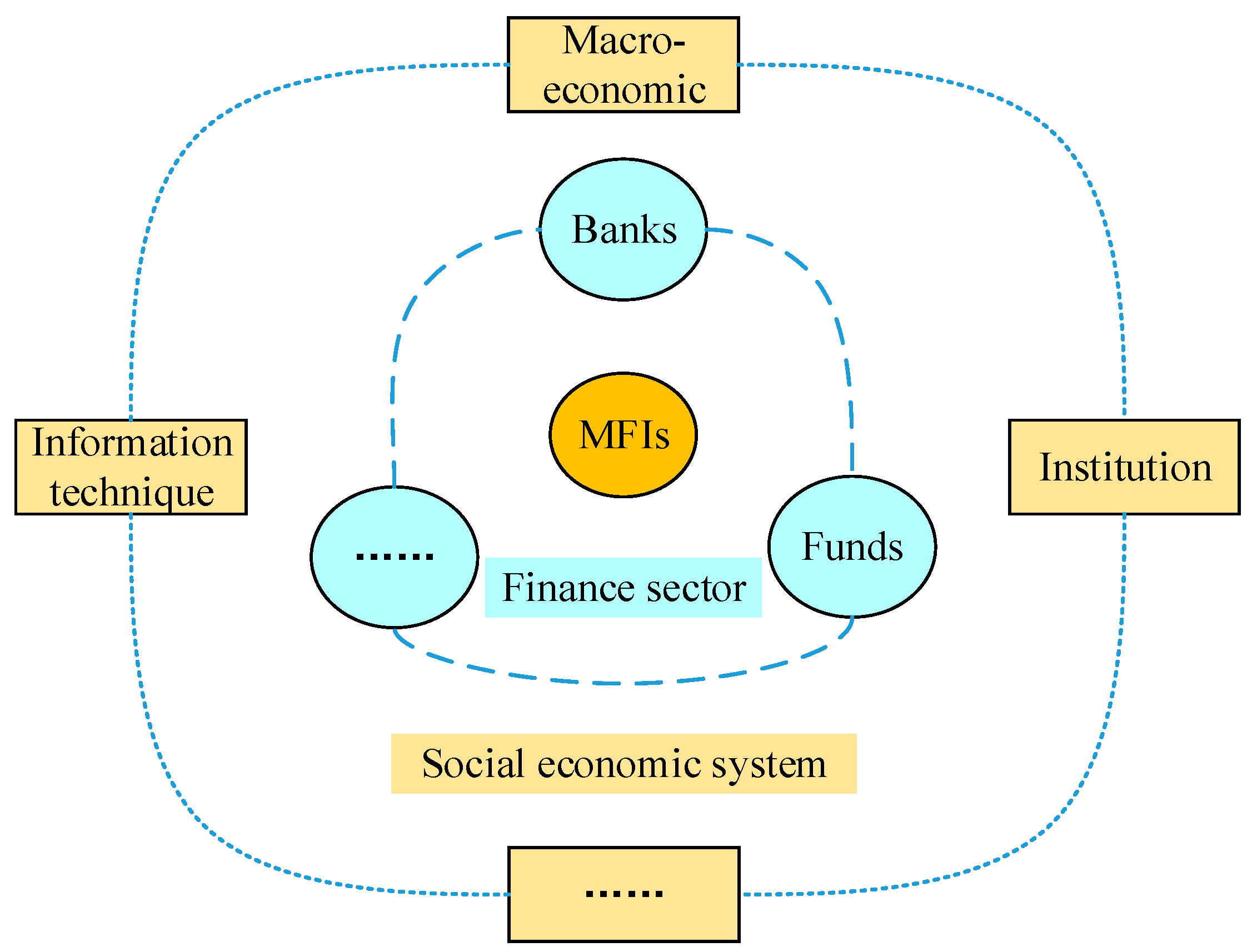
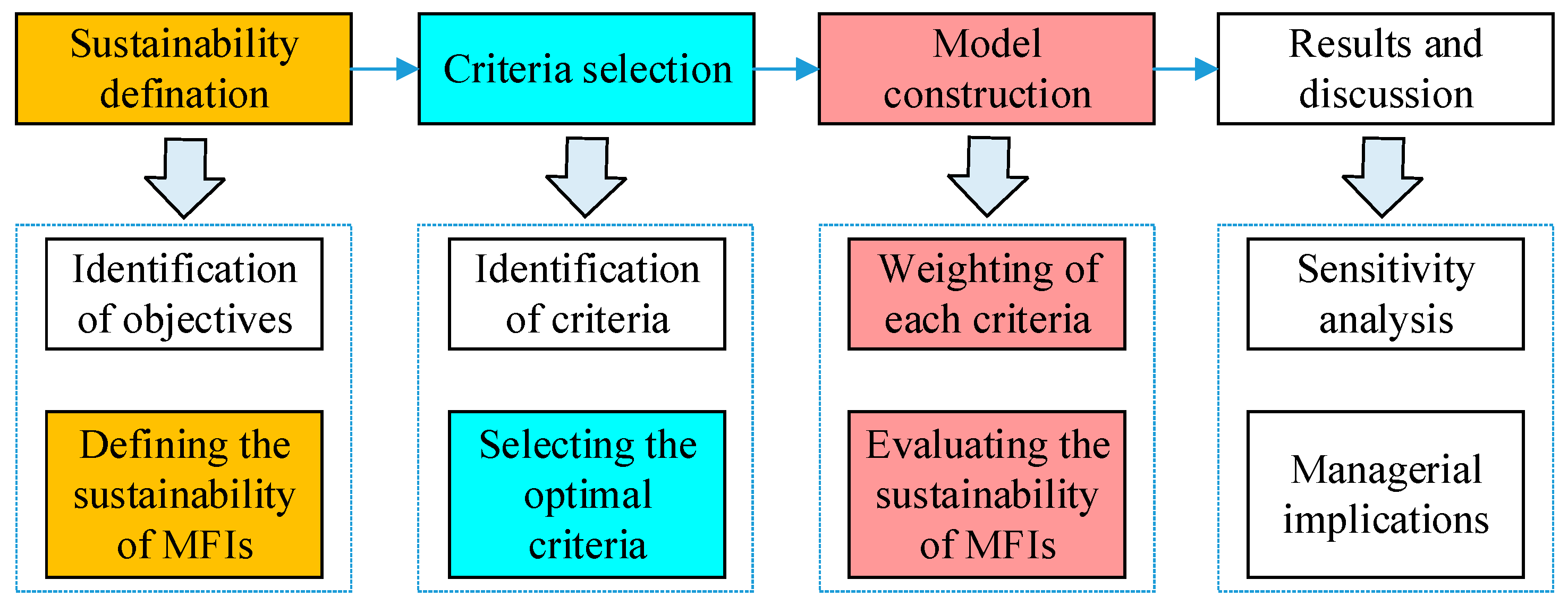
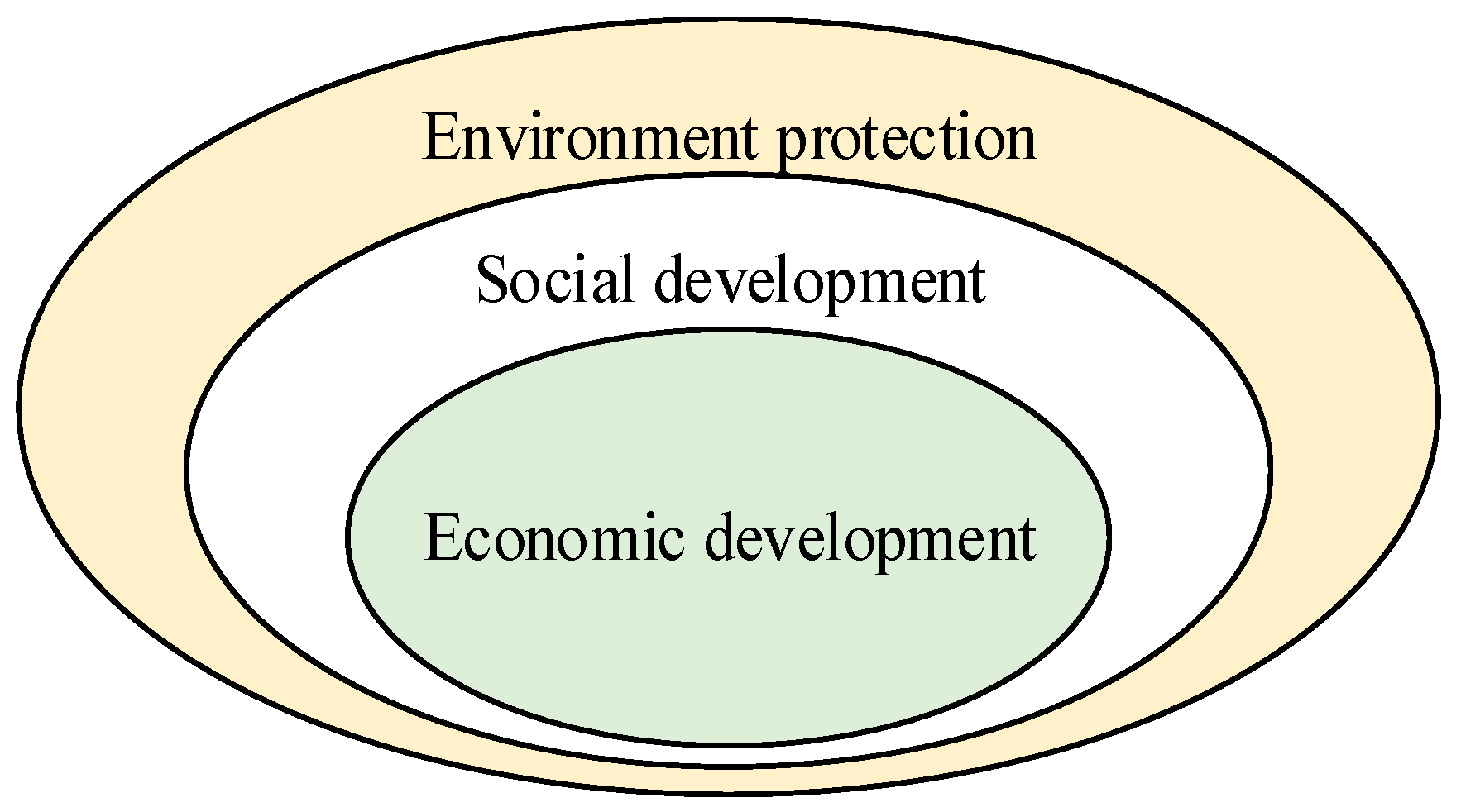

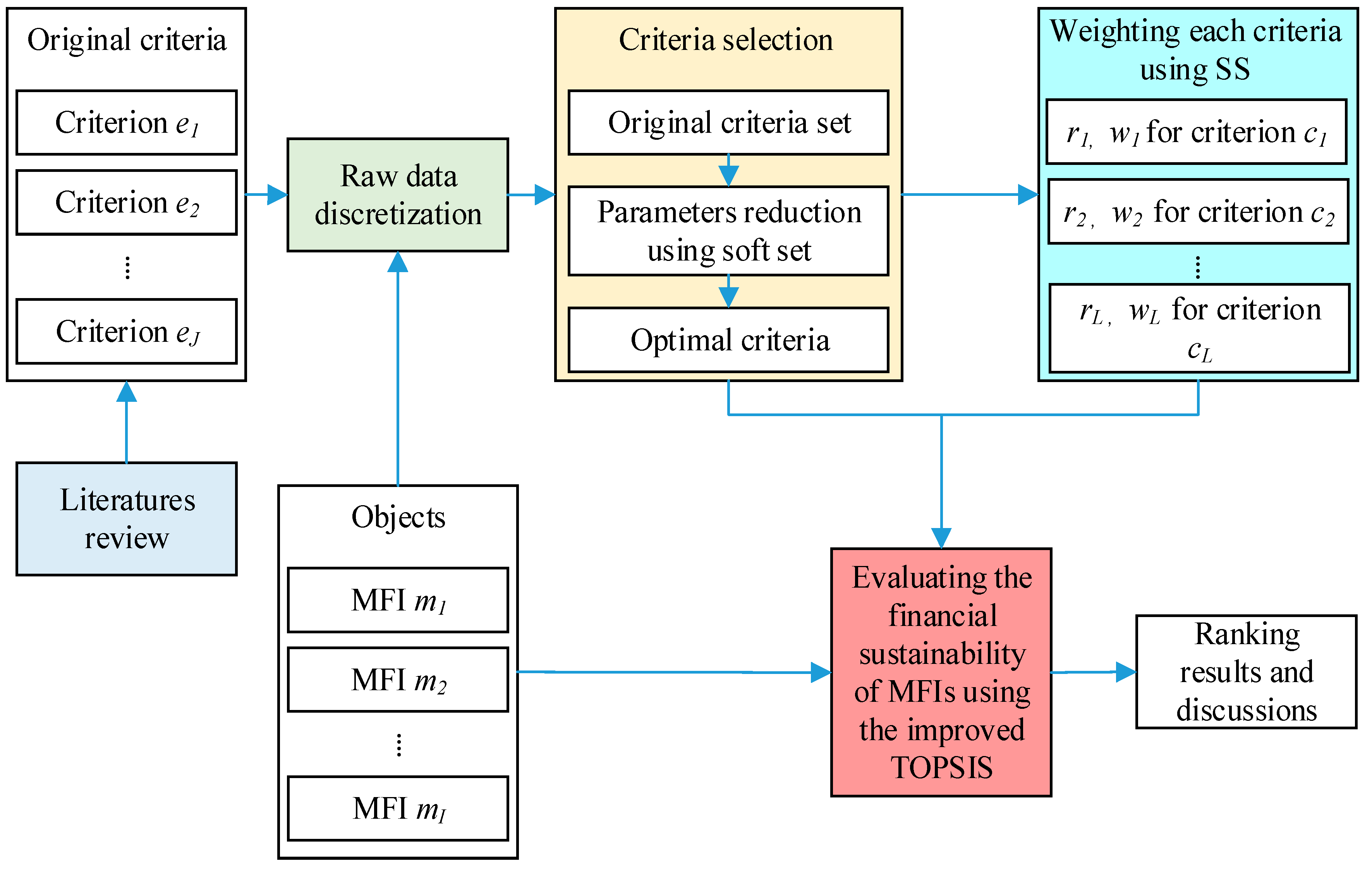
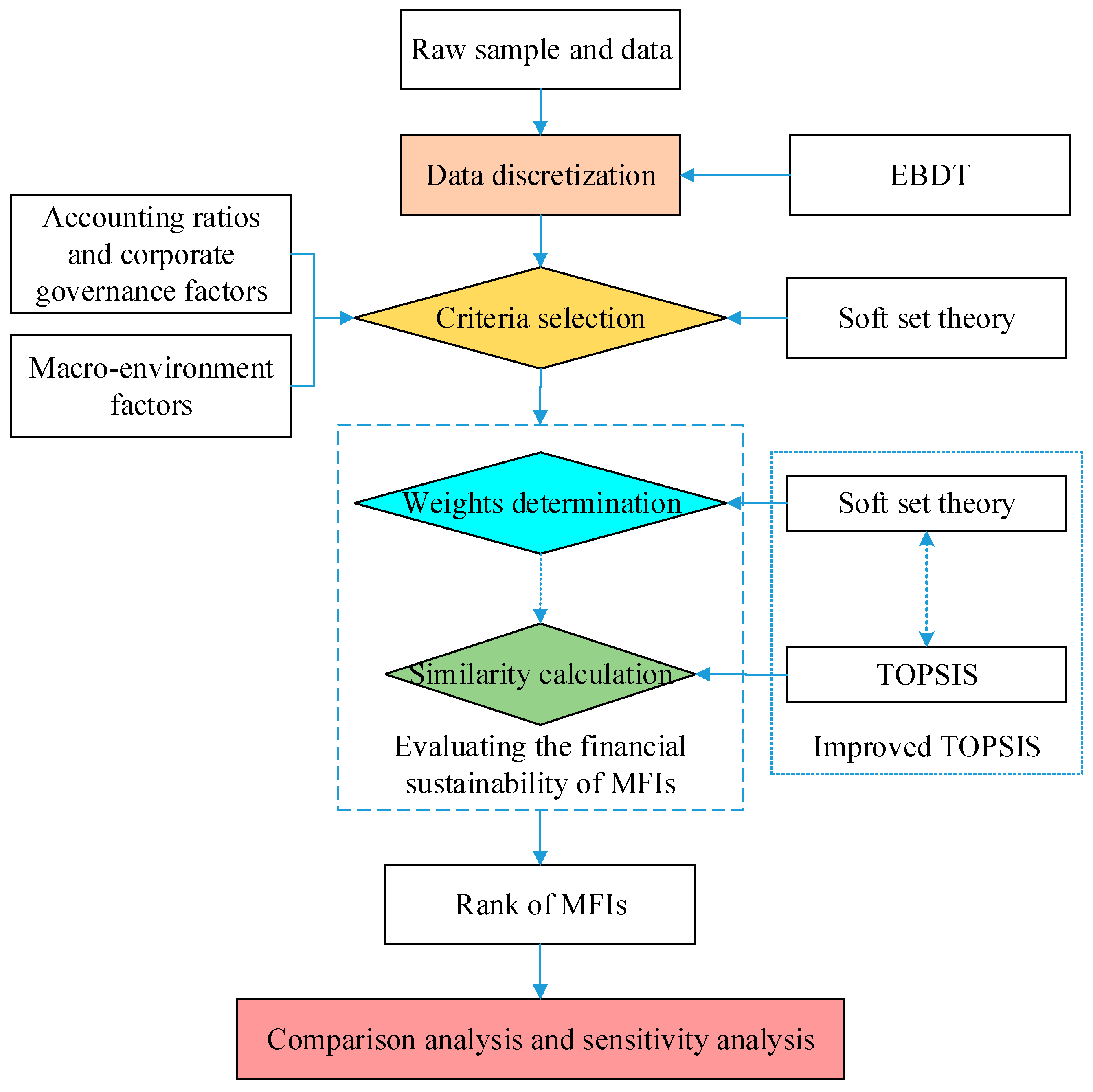
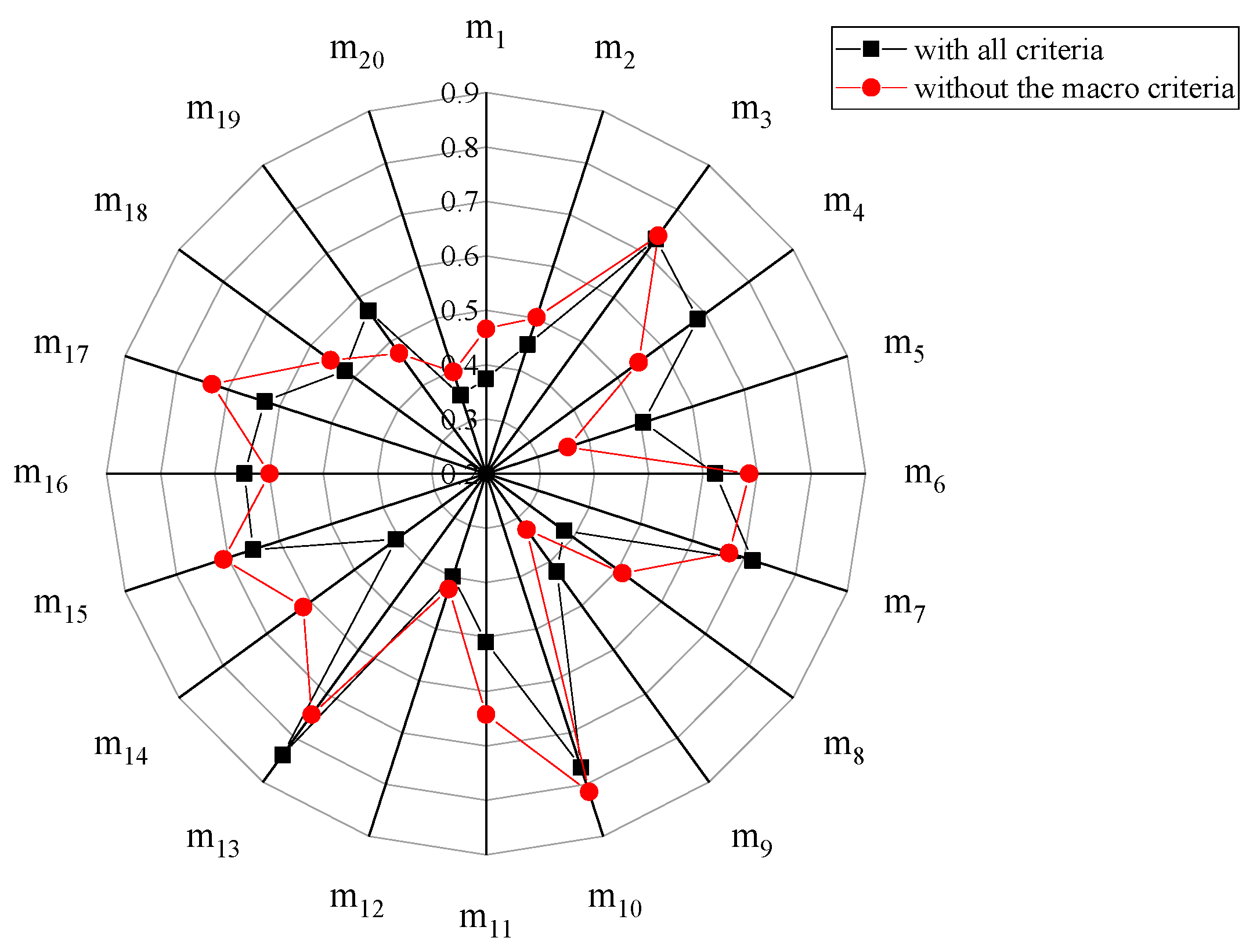
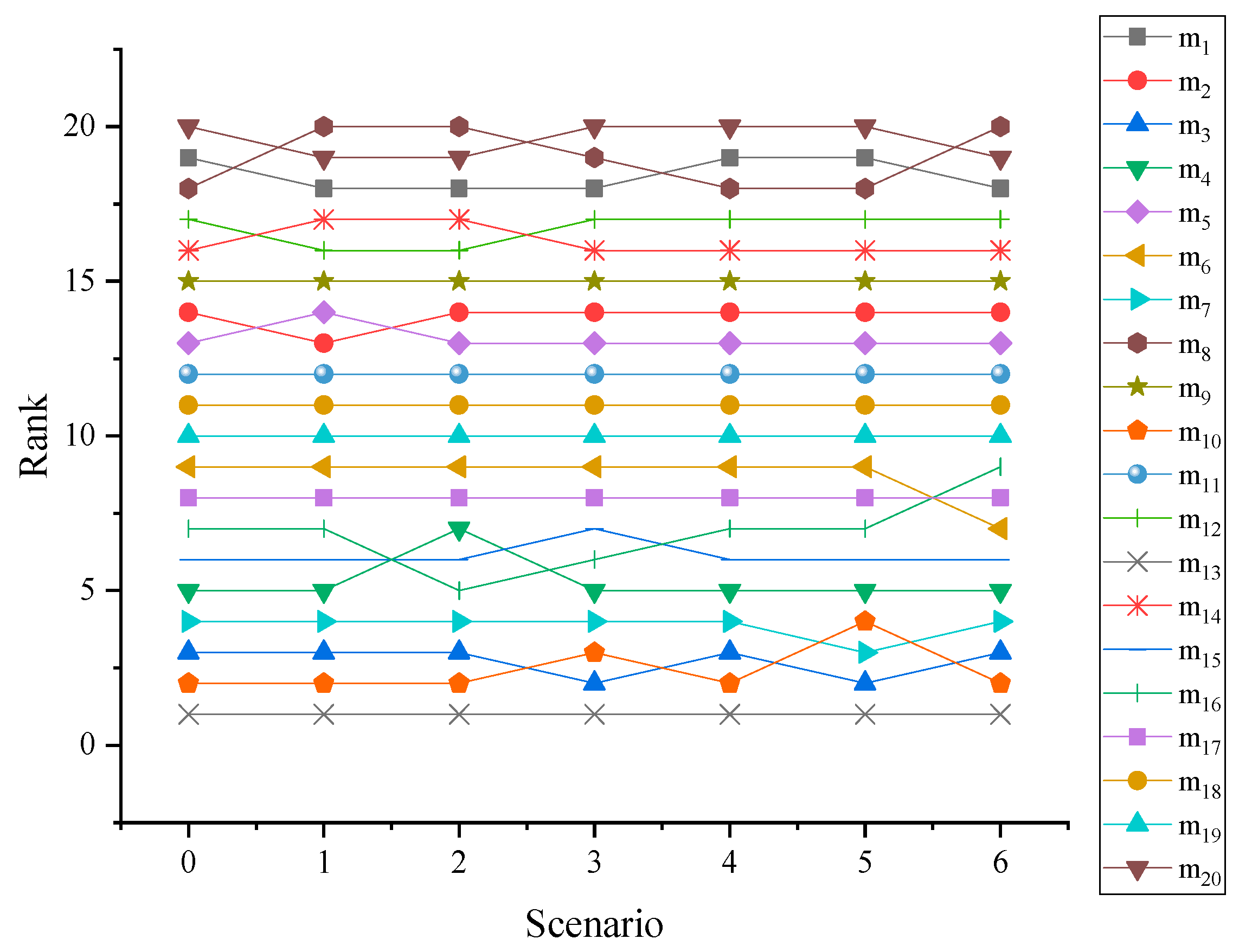
| Region | Number | Percentage |
|---|---|---|
| Africa | 1309 | 28.60% |
| East Asia and the Pacific (EAP) | 623 | 13.61% |
| Eastern Europe and Central Asia (EECA) | 672 | 14.68% |
| Latin America and Caribbean (LAC) | 828 | 18.09% |
| Middle East and North Africa (MENA) | 125 | 2.73% |
| North American (NA) | 148 | 3.23% |
| Oceania | 3 | 0.07% |
| South Asia (SA) | 653 | 14.27% |
| Unspecified | 23 | 0.50% |
| Western Europe (WE) | 193 | 4.22% |
| Total | 4577 | 100% |
| No. (Number) | MFIs | Type | Country | Region |
|---|---|---|---|---|
| AMC | NBFI | Jordan | MENA | |
| SOMALI | NBFI | Ethiopia | Africa | |
| CONSORZIO ETIMOS | CU/CC | Italy | WE | |
| CARECANADA | CU/CC | Canada | NA | |
| RADUGA | CU/CC | Russia | EECA | |
| FIRST MACRO BANK | Rural Bank | Philippines | EAP | |
| GRAMEEN BANK | Bank | Bangladesh | SA | |
| CBB | Rural Bank | Nepal | SA | |
| CARE GTM | NGO | Guatemala | LAC | |
| AB MFB | Bank | Nigeria | Africa | |
| EDESA | NBFI | Costa Rica | LAC | |
| YRYS | NBFI | Kazakhstan | EECA | |
| ABC CAPITAL | Bank | Mexico | LAC | |
| CECAP | CU/CC | Senegal | Africa | |
| MI CASITA | NBFI | Peru | LAC | |
| SEKER BANK | Bank | Turkey | EECA | |
| BADUMAN RB | Rural Bank | Ghana | Africa | |
| YEHU | NGO | Kenya | Africa | |
| AID | NGO | India | SA | |
| M7 STU | NGO | Vietnam | EAP |
| No. | Criterion | Definition | Unit | Property |
|---|---|---|---|---|
| Operational Self-Sufficiency Ratio | Financial revenue/(financial expense + impairment loss + operating expense) | % | Positive | |
| Return on Asset | (Net operating income, less taxes)/total assets | % | Positive | |
| Leverage | Total liabilities/total equity | % | Negative | |
| Operating Revenues | Current revenues (current transfers, grants, services revenues, tax revenues) | USD | Positive | |
| Debt ratio | (Total liabilities—financial assets)/total assets | % | Negative | |
| Cost per Borrower | Operating expense/number of active borrowers, average | USD | Negative | |
| Loan Loss Ratio | (Write-off value of loans recovered)/loan portfolio, gross, average | % | Negative | |
| Portfolio Yield | [(Interest, fees, and commissions on loan portfolio/average gross loan portfolio)—inflation rate]/(1 + inflation rate) | % | Positive | |
| Portfolio at Risk | Value of loans at risk N 30 days/average gross loan portfolio | USD | Negative | |
| Profit Orientation | 1 if the MFI is for profit, otherwise 0 | – | Positive | |
| Load to Women | 1 if the MFI loads to women, otherwise = 0 | % | Negative | |
| Scale | The scale is based on the number of active borrowers | 1000 | Positive | |
| Age | The operation years of a MFI | YEAR | Positive | |
| Financial Intermediation | 1 if the MFI uses significant deposits (N 20% of total asset) to finance its assets, otherwise 0 | – | Negative | |
| Borrowers per Loan Officer | Borrowers/loan officer | – | Positive | |
| Regulate State | 1 if the entity is submitted to some regulatory authority, otherwise = 0 | – | Positive | |
| Website Accessibility | Website accessibility measures whether the MFI has a website or not, and the languages used to disclose information | – | Positive | |
| Internet Penetration | The number of people who have access to the Internet per 100 people in a country | % | Positive | |
| GDP Growth | GDP growth rate | % | Positive | |
| Rural Population | Proportion of people living in rural areas in a country | % | Negative | |
| Corruption | The scores of corruption range from 0 (no corruption)–100 (highly corrupt) | – | Negative | |
| Index of Economic Freedom | EF, which is graded on a scale of 0 to 100, is used to reflect the economic freedom and the level of government regulation of a country | – | Positive | |
| Ease of Doing Business Index | The scores of ease of doing business index ranging from 1 (high) to 190 (low) | – | Positive | |
| Financial Development | Private credit/total GDP | % | Positive | |
| Depth of Credit Information Index | The scores of depth of credit information index, ranging from 0 (low) to 8 (high) | – | Positive | |
| Getting Credit | Graded on a scale of 0 to 100 | – | Positive |
| Objects | ||||
|---|---|---|---|---|
| No. | Criterion | No. | Criterion |
|---|---|---|---|
| Operational self-sufficiency ratio | Portfolio at risk | ||
| Profit orientation | Scale | ||
| Regulate state | Index of economic freedom | ||
| Depth of credit information index |
| Weight | |||||||
|---|---|---|---|---|---|---|---|
| 0.750 | 0.550 | 0.650 | 0.300 | 0.600 | 0.500 | 0.350 | |
| 0.203 | 0.149 | 0.176 | 0.081 | 0.162 | 0.135 | 0.095 |
| No. | Similarity | Rank | No. | Similarity | Rank |
|---|---|---|---|---|---|
| 0.375 | 19 | 0.509 | 12 | ||
| 0.450 | 14 | 0.399 | 17 | ||
| 0.733 | 3 | 0.838 | 1 | ||
| 0.683 | 5 | 0.405 | 16 | ||
| 0.505 | 13 | 0.652 | 6 | ||
| 0.623 | 9 | 0.646 | 7 | ||
| 0.717 | 4 | 0.630 | 8 | ||
| 0.378 | 18 | 0.522 | 11 | ||
| 0.422 | 15 | 0.570 | 10 | ||
| 0.767 | 2 | 0.352 | 20 |
| Weight | |||||
|---|---|---|---|---|---|
| 0.800 | 0.550 | 0.700 | 0.650 | 0.600 | |
| 0.242 | 0.167 | 0.212 | 0.197 | 0.182 |
| No. | Similarity | Rank | No. | Similarity | Rank |
|---|---|---|---|---|---|
| 0.466 | 16 | 0.642 | 8 | ||
| 0.502 | 14 | 0.423 | 17 | ||
| 0.740 | 3 | 0.747 | 2 | ||
| 0.548 | 12 | 0.617 | 9 | ||
| 0.358 | 19 | 0.709 | 5 | ||
| 0.686 | 6 | 0.599 | 10 | ||
| 0.671 | 7 | 0.732 | 4 | ||
| 0.511 | 13 | 0.554 | 11 | ||
| 0.327 | 20 | 0.473 | 15 | ||
| 0.814 | 1 | 0.397 | 18 |
| No. | Origin | Scenario 1 | Scenario 2 | Scenario 3 | Scenario 4 | Scenario 5 | Scenario 6 |
|---|---|---|---|---|---|---|---|
| 0.203 | 0.261 | 0.225 | 0.198 | 0.204 | 0.184 | 0.215 | |
| 0.149 | 0.202 | 0.197 | 0.192 | 0.173 | 0.182 | 0.112 | |
| 0.176 | 0.116 | 0.186 | 0.145 | 0.147 | 0.108 | 0.223 | |
| 0.081 | 0.091 | 0.092 | 0.092 | 0.093 | 0.117 | 0.092 | |
| 0.162 | 0.107 | 0.105 | 0.109 | 0.171 | 0.165 | 0.165 | |
| 0.135 | 0.119 | 0.121 | 0.122 | 0.119 | 0.140 | 0.121 | |
| 0.095 | 0.104 | 0.074 | 0.142 | 0.093 | 0.105 | 0.073 |
| MFIs | Origin | Scenario 1 | Scenario 2 | Scenario 3 | Scenario 4 | Scenario 5 | Scenario 6 |
|---|---|---|---|---|---|---|---|
| Similarity (Rank) | Similarity (Rank) | Similarity (Rank) | Similarity (Rank) | Similarity (Rank) | Similarity (Rank) | Similarity (Rank) | |
| 0.375 (19) | 0.325 (18) | 0.346 (18) | 0.361 (18) | 0.355 (19) | 0.312 (19) | 0.396 (18) | |
| 0.450 (14) | 0.487 (13) | 0.480 (14) | 0.439 (14) | 0.459 (14) | 0.415 (14) | 0.462 (14) | |
| 0.733 (3) | 0.752 (3) | 0.718 (3) | 0.752 (2) | 0.742 (3) | 0.745 (2) | 0.761 (3) | |
| 0.683 (5) | 0.725 (5) | 0.662 (7) | 0.729 (5) | 0.691 (5) | 0.703 (5) | 0.702 (5) | |
| 0.505 (13) | 0.475 (14) | 0.481 (13) | 0.481 (13) | 0.511 (13) | 0.472 (13) | 0.526 (13) | |
| 0.623 (9) | 0.635 (9) | 0.652 (9) | 0.612 (9) | 0.636 (9) | 0.597 (9) | 0.648 (7) | |
| 0.717 (4) | 0.738 (4) | 0.709 (4) | 0.736 (4) | 0.721 (4) | 0.729 (3) | 0.716 (4) | |
| 0.378 (18) | 0.298 (20) | 0.308 (20) | 0.342 (19) | 0.378 (18) | 0.322 (18) | 0.315 (20) | |
| 0.422 (15) | 0.462 (15) | 0.459 (15) | 0.411 (15) | 0.418 (15) | 0.390 (15) | 0.447 (15) | |
| 0.767 (2) | 0.816 (2) | 0.801 (2) | 0.751 (3) | 0.788 (2) | 0.726 (4) | 0.799 (2) | |
| 0.509 (12) | 0.543 (12) | 0.534 (12) | 0.4994 (12) | 0.512 (12) | 0.479 (12) | 0.5294 (12) | |
| 0.399 (17) | 0.437 (16) | 0.428 (16) | 0.378 (17) | 0.385 (17) | 0.364 (17) | 0.412 (17) | |
| 0.838 (1) | 0.872 (1) | 0.854 (1) | 0.813 (1) | 0.842 (1) | 0.805 (1) | 0.842 (1) | |
| 0.405 (16) | 0.413 (17) | 0.412 (17) | 0.392 (16) | 0.402 (16) | 0.378 (16) | 0.432 (16) | |
| 0.652 (6) | 0.714 (6) | 0.681 (6) | 0.621 (7) | 0.668 (6) | 0.623 (6) | 0.678 (6) | |
| 0.646 (7) | 0.709 (7) | 0.685 (5) | 0.635 (6) | 0.6558 (7) | 0.615 (7) | 0.637 (9) | |
| 0.630 (8) | 0.662 (8) | 0.659 (8) | 0.619 (8) | 0.636 (8) | 0.599 (8) | 0.642 (8) | |
| 0.522 (11) | 0.565 (11) | 0.551 (11) | 0.507 (11) | 0.530 (11) | 0.491 (11) | 0.543 (11) | |
| 0.570 (10) | 0.603 (10) | 0.596 (10) | 0.556 (10) | 0.571 (10) | 0.539 (10) | 0.586 (10) | |
| 0.352 (20) | 0.302 (19) | 0.316 (19) | 0.321 (20) | 0.342 (20) | 0.306 (20) | 0.320 (19) |
© 2019 by the authors. Licensee MDPI, Basel, Switzerland. This article is an open access article distributed under the terms and conditions of the Creative Commons Attribution (CC BY) license (http://creativecommons.org/licenses/by/4.0/).
Share and Cite
Xu, W.; Fu, H.; Liu, H. Evaluating the Sustainability of Microfinance Institutions Considering Macro-Environmental Factors: A Cross-Country Study. Sustainability 2019, 11, 5947. https://doi.org/10.3390/su11215947
Xu W, Fu H, Liu H. Evaluating the Sustainability of Microfinance Institutions Considering Macro-Environmental Factors: A Cross-Country Study. Sustainability. 2019; 11(21):5947. https://doi.org/10.3390/su11215947
Chicago/Turabian StyleXu, Wei, Hongyong Fu, and Huanpeng Liu. 2019. "Evaluating the Sustainability of Microfinance Institutions Considering Macro-Environmental Factors: A Cross-Country Study" Sustainability 11, no. 21: 5947. https://doi.org/10.3390/su11215947
APA StyleXu, W., Fu, H., & Liu, H. (2019). Evaluating the Sustainability of Microfinance Institutions Considering Macro-Environmental Factors: A Cross-Country Study. Sustainability, 11(21), 5947. https://doi.org/10.3390/su11215947




